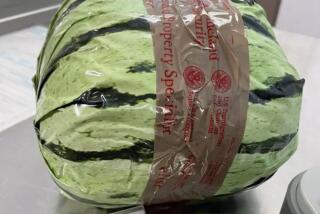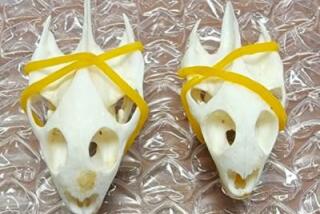Ride Turns Exotic for Smuggled Creatures : Wildlife: Customs agents have found animals concealed in suitcases, breast pockets, even teddy bears. Poisonous frogs, snakes, fruit bats, spiders and tiny monkeys are among the contraband.
- Share via
MIAMI — It’s a zoo getting through customs sometimes. Snakes and poisonous frogs are secreted in suitcases, turtles get zipped up in teddy bears and five-inch monkeys are slyly tucked into a breast pocket. One wildlife agent says he once found live birds taped to someone’s body.
“The pet trade goes through its fads,” U.S. Fish and Wildlife agent Eddie McKissick said. “Now it’s poisonous frogs from South America. A few months ago it was Egyptian fruit bats from Africa.”
In the latest beastly border crossing, a Miami man tried to smuggle in about 300 so-called poison arrow frogs on a flight from Venezuela. The black-and-yellow frogs secrete a poison used by Amazon Indians for arrows and darts.
“This same guy had 14 boa constrictors, about 200 bird-eating spiders and a bunch of spider egg sacs,” McKissick said. “We’re hatching the egg sacs in an incubator to see if they’re the same kind of bird eaters.”
Customs agents usually are the first to find or suspect concealed animals, McKissick said. A fish and wildlife agent is then called over for a thorough search.
The agent who found the frogs also found the snakes as she rummaged through the man’s suitcase.
“The agent really went off like a rocket when she found this guy had let her go digging around in his suitcase with poisonous frogs in there,” he said.
The frogs were inside three bottles labeled horse shampoo; the snakes in cloth bags and the spiders in unmarked plastic containers. Once in the country, the frogs and spiders could be sold for about $65 each, the boas are worth about $300 each.
Just when McKissick and other agents think they’ve figured out all the tricks, someone comes up with a new one.
“I took a live boa out of a guy’s shirt one day at customs,” McKissick said. He also has found pygmy marmosets--a five-inch-high primate--in someone’s pockets and in a waist pack.
“One time this woman came toting this humongous teddy bear through the customs area,” McKissick said. “A customs agent saw a bulge in the bear. She touched it and the bulge moved. The woman had sewn up all these snakes and tortoises inside that bear.”
McKissick estimates that only 10% to 20% of the smuggled animals are found.
More to Read
Sign up for The Wild
We’ll help you find the best places to hike, bike and run, as well as the perfect silent spots for meditation and yoga.
You may occasionally receive promotional content from the Los Angeles Times.






